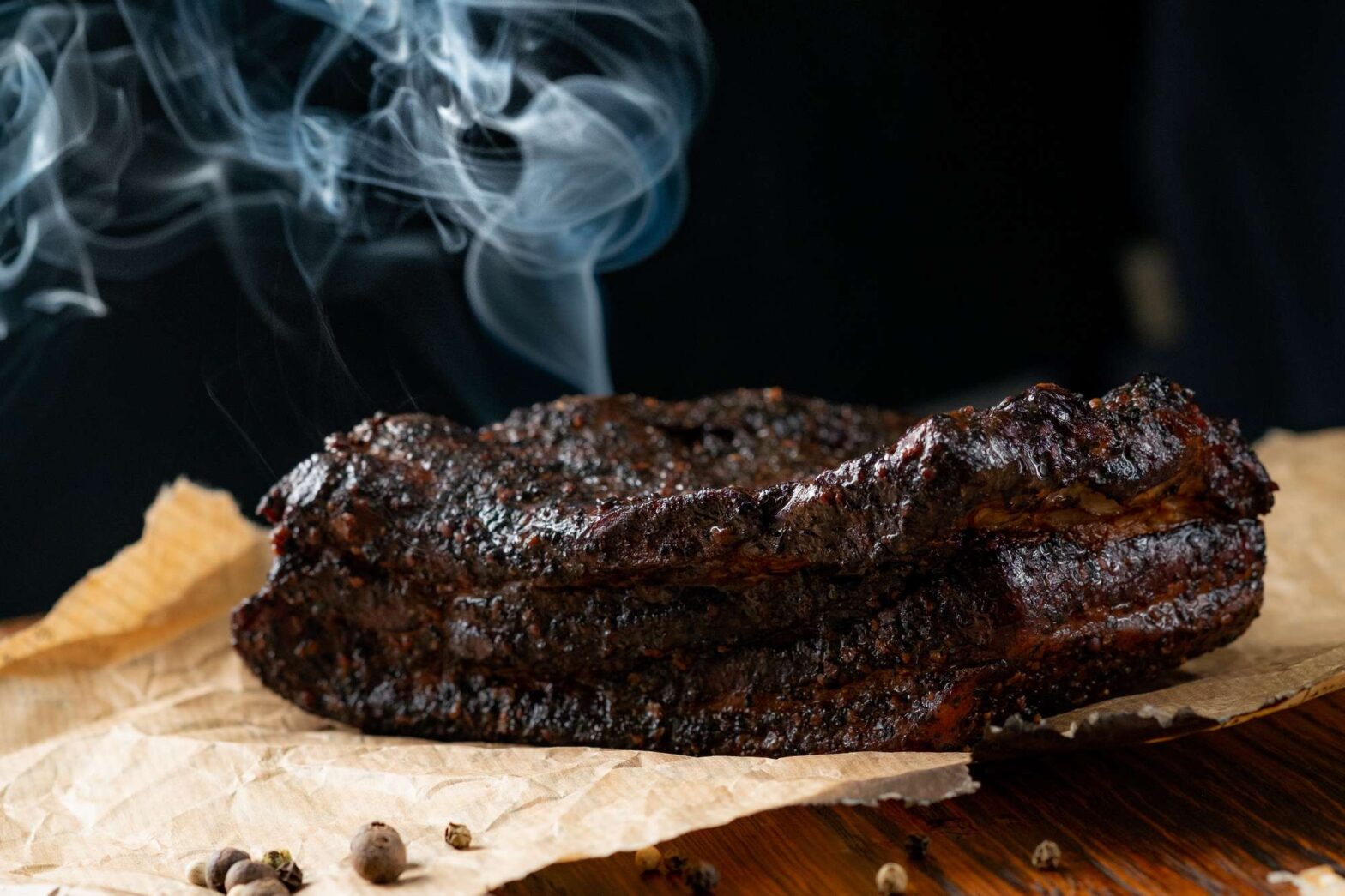“Do you eat the bark on a brisket?” This is what John S. from South Pittsburg, a quaint city in Marion County, Tennessee, population 3,051 (2019), emailed us to ask.
The long and short of it, John, is yes. But only if you want to.
Generally, the bark on brisket is edible. Smoky, crispy, and deeply flavorsome, the fact of the matter is that the bark can be one of the most delicious parts of a well-smoked brisket.
When you smoke brisket, the thin, bluish fumes flavor the meat as the hot air, which rises up to escape through the cooking chamber to the chimney, cooks the meat low and slow.
The bark is that crispy, flavorsome crust that forms on the outside of the brisket from the fat, the juices, the seasoning, and the so-called Maillard that takes place during this process.
Bark formation is a prized skill, especially in meat-smoking competitions. A great deal of recipes and techniques for smoked brisket are developed specifically to build the bark, and for good reason: it ameliorates the hunk of meat in more than one way, taking its aroma, flavor, and mouthfeel to a whole new level.
Why Does the Bark Form?
The bark is, to a large extent, the result of the Maillard reaction.
In its simplest form, the Maillard reaction is a chain of chemical events that take place on the surface of the brisket when it’s heated to a certain temperature for a long enough time.
This reaction is catalyzed mostly by heat, particularly high heat, like when you’re searing steaks directly over the coals in a charcoal grill. However, it can occur at the gentle heat of the smoker, albeit slowly, especially with long cooks.
Named after Louis Camille Maillard, the French chemist who discovered it in 1912, the Maillard reaction is said to occur when the proteins and the carbohydrates on the surface of protein-rich foods get charged up with so much energy from the heat, they begin to shake and tremble violently.
They shake and tremble so much that, eventually, they collide and fuse with one another. Each collision creates tiny bursts of aroma and flavor invisible to the naked eye. These bursts add up, giving the bark a charred color and imparting the brisket with a meaty smell and savory flavor.
A brisket with bark is a brisket that tastes better. “The Maillard,” as some call it, is also why seared steak, rotisserie chicken, golden-brown bread, and even roasted coffee smell and taste so good.
“That’s all good, Sammy,” I hear you saying. “But the question is, am I supposed to eat it?”
Should You Eat the Bark?
If you find the bark appetizing, and many diners do, by all means, enjoy it.
Whether you make yourself a brisket sandwich or send slices of brisket to the table alongside coleslaw, grilled corn, and/or BBQ beans, the serving options are limited only by your imagination and the ingredients resting in your fridge.
Depending on how you smoke the brisket, the bark can come out dry and crunchy or moist and pliable. (To find out why, take a gander at “Why Is the Bark on My Brisket Wet?”)
Whether you build your bark one way or another comes down to what you, the meat smoker, and the family, a.k.a. the hungry crowd at the table, prefer.
Is It Bad for You?
Now, I’ve heard some concerns, from family members and neighbors, about whether or not eating the bark of a brisket is harmful. It’s no surprise folks are asking this question, given how much fuss is made about processed meat (and, lately, meat as a whole).
I ain’t no expert on the subject, that’s for sure. But, as any good culinary journalist, I’m an expert of quoting experts. (If, of course, that can be counted as a skill.)
So here it goes:
One of the many compounds that get formed during the Maillard reaction is called acrylamide.
According to the National Cancer Institute, the body converts acrylamide into a compound called glycidamide, which is known to cause mutations in—and damage to—the DNA in our cells.
At the same time, the institute staff point out, a large number of studies have been conducted over the years that have failed to provide consistent evidence that dietary acrylamide intake is associated with a cancer risk.
Apart from the bark of your brisket, acrylamides can be found in French fries, bread, cookies, breakfast cereals, and even roasted coffee beans. Basically, in anything that browns and thus undergoes the Maillard reaction when heated.
Expectedly, this has prompted researchers to start asking some hard questions.
“Acrylamide caused cancer in animals in studies where animals were exposed to acrylamide at very high doses,” the Food & Drug Administration points out on its website.
However, those laboratory studies exposed the animals to much higher levels of acrylamide than those found in foods.
“In 2010, the Joint Food and Agriculture Organization/World Health Organization Expert Committee on Food Additives (JECFA),” the article continues, “concluded that acrylamide is a human health concern—and suggested additional long-term studies.”
In other words, there does not seem to be conclusive data to prove that the crispy, flavorsome crust on a brisket is bad for you. Until this changes, I consume mine guilt-free, served alongside an abundance of veg as the experts have advised me.


